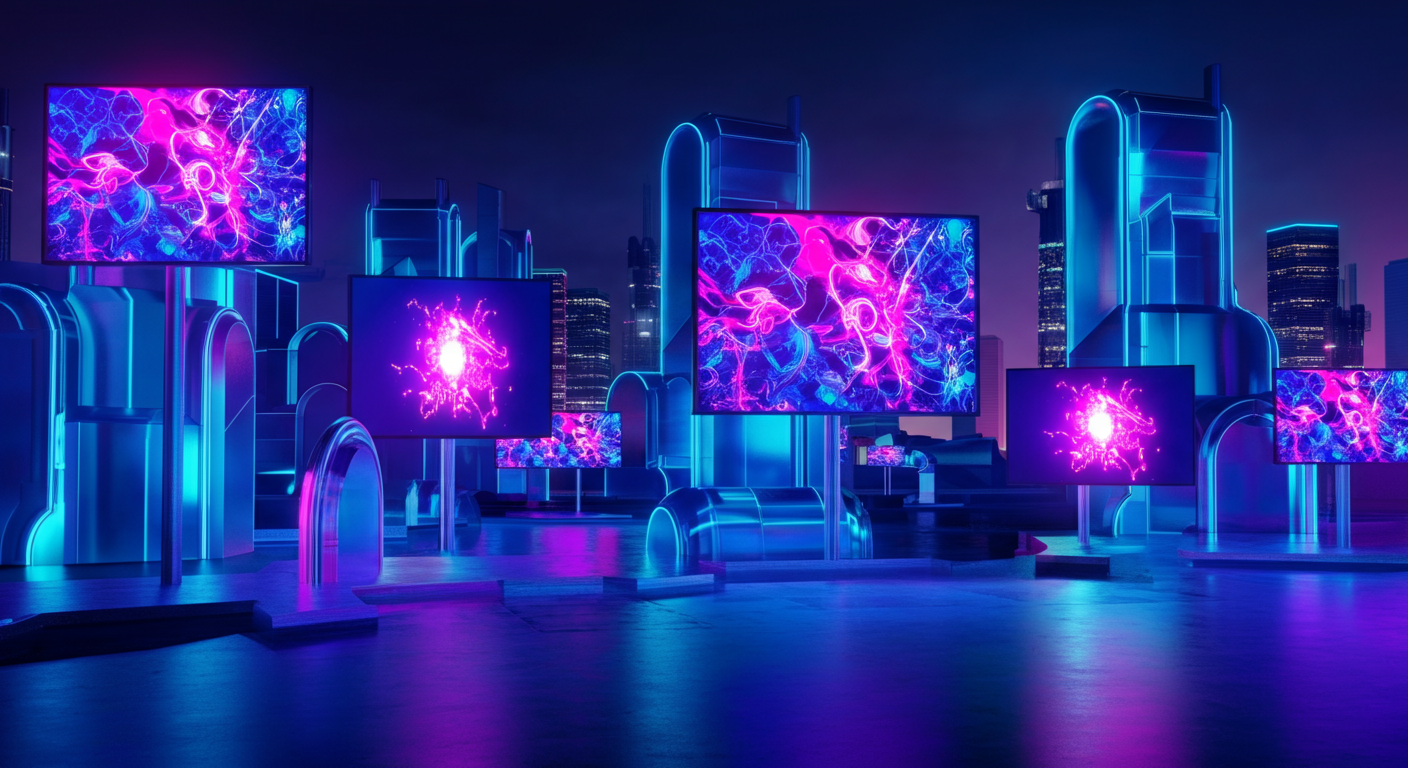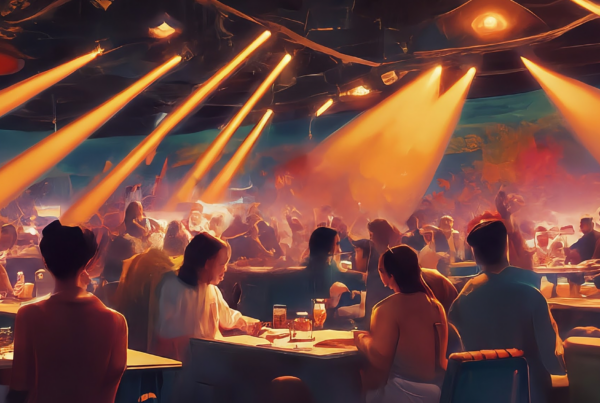In today’s rapidly evolving digital landscape, staying ahead of the curve is crucial for businesses in the hospitality and entertainment industries. With the rise of innovative technologies and changing consumer preferences, understanding the trends in commercial video solutions is more important than ever. As we look towards 2025, these trends are not just shaping the way businesses entertain their customers but are also redefining how they engage and connect with audiences.
Imagine walking into a bustling casino or a lively restaurant, where the atmosphere is enriched by cutting-edge video displays that captivate and entertain. This isn’t just about providing entertainment; it’s about creating an immersive experience that enhances customer satisfaction and loyalty. For multi-location organizations, such as restaurant chains or casinos, adopting the latest business entertainment solutions can offer a centralized approach to delivering consistent, high-quality content across all venues.
At DLM Media, we understand the significance of these emerging trends. Our mission is to provide businesses with reliable and innovative commercial video programming solutions that not only entertain but also elevate the overall customer experience. From digital signage solutions to hospitality TV packages, we offer a range of services designed to meet the unique needs of various industries, ensuring that your business remains at the forefront of entertainment technology.
In this blog post, we will explore the key trends shaping the future of commercial video solutions for 2025. From the integration of AI and machine learning to the rise of interactive and shoppable videos, we’ll delve into how these innovations can transform your business. Join us as we uncover the potential of these technologies and provide insights on how to leverage them effectively.
AI and Machine Learning Revolutionizing Video Solutions
As we approach 2025, the integration of AI and machine learning into video solutions is transforming the industry, driving automation and personalization to new heights. This evolution is crucial for businesses aiming to stay competitive in the rapidly changing landscape of commercial video solutions. AI’s role in streamlining production processes and enhancing viewer engagement is increasingly acknowledged by industry leaders.
AI and machine learning are not just buzzwords; they are practical tools that are revolutionizing how video content is created and consumed. By automating labor-intensive tasks such as editing, captioning, and even scriptwriting, AI significantly reduces production costs and time. This allows businesses to allocate resources more efficiently and focus on creative aspects, ultimately improving the quality and impact of their video content.
AI Applications in Video Production
Incorporating AI into video production has led to remarkable advancements. AI-powered tools can automate editing processes, ensuring consistency and precision that human editors might miss. For instance, AI algorithms can analyze footage to identify the best shots, seamlessly stitching them together to create a polished final product. This not only saves time but also enhances the overall quality of the video.
Moreover, AI is instrumental in generating realistic visual effects and animations, which were once costly and time-consuming. By leveraging machine learning, video producers can create stunning visuals that captivate audiences without breaking the bank. This democratization of high-quality video production allows even smaller businesses to compete with industry giants.
Enhancing Personalization and Viewer Engagement
AI’s impact extends beyond production; it plays a pivotal role in personalizing viewer experiences. Machine learning algorithms analyze viewer data to tailor content recommendations, ensuring that audiences receive content that resonates with their preferences. This personalization increases viewer engagement and retention, crucial metrics for businesses relying on video content to drive sales and brand loyalty.
Additionally, AI enables real-time interaction with viewers through features like chatbots and interactive video elements. These innovations foster a more engaging and immersive viewing experience, encouraging viewers to interact with the content and, by extension, the brand.
Impact on Cost and Efficiency
The integration of AI and machine learning into video solutions not only enhances quality and engagement but also significantly impacts cost and efficiency. By automating repetitive tasks, businesses can reduce labor costs and expedite production timelines. This efficiency allows companies to produce more content at a faster rate, meeting the growing demand for video in marketing and entertainment.
Furthermore, AI-driven analytics provide valuable insights into viewer behavior, enabling businesses to optimize their content strategies. By understanding which elements of a video resonate most with audiences, companies can refine their approaches, ensuring maximum return on investment.
In conclusion, the adoption of AI and machine learning in video solutions is not just a trend; it is a revolution that is reshaping the industry. As we move towards 2025, businesses that embrace these technologies will find themselves at the forefront of innovation, delivering engaging and cost-effective video content that captivates audiences worldwide.
Interactive and Immersive Video Experiences
As we move towards 2025, the landscape of commercial video solutions is being transformed by the rise of interactive and immersive video experiences. Technologies such as Augmented Reality (AR) and Virtual Reality (VR) are at the forefront of this revolution, offering businesses innovative ways to engage with their customers. These technologies are not just about entertainment; they are about creating a deeper connection with audiences, enhancing customer satisfaction, and driving business growth.
Interactive and immersive video solutions are gaining traction across various industries, from hospitality to retail. Businesses are leveraging these technologies to create unique and engaging customer experiences that set them apart from the competition. By integrating AR and VR into their video strategies, companies can offer customers a more personalized and engaging experience, ultimately leading to increased loyalty and sales.
Augmented Reality (AR) in Commercial Settings
Augmented Reality (AR) is revolutionizing the way businesses interact with their customers. In commercial settings, AR can be used to enhance the customer experience by overlaying digital information onto the physical world. For instance, restaurants can use AR to provide interactive menus that allow customers to see detailed information about dishes, including ingredients and nutritional information. This not only enhances the dining experience but also helps customers make informed choices.
Retailers are also embracing AR to create immersive shopping experiences. By using AR applications, customers can virtually try on clothes or see how furniture would look in their homes before making a purchase. This technology reduces the uncertainty associated with online shopping and increases customer confidence, leading to higher conversion rates. According to a report by Statista, the AR market is projected to reach $62 billion by 2029, highlighting its growing importance in the commercial sector.
Virtual Reality (VR) Transforming Customer Engagement
Virtual Reality (VR) offers businesses the opportunity to create fully immersive experiences that transport customers to different environments. In the hospitality industry, VR can be used to provide virtual tours of hotels or resorts, allowing potential guests to explore the facilities before booking. This not only enhances the customer experience but also helps businesses showcase their offerings in a more engaging way.
Moreover, VR is being used in training and development, providing employees with realistic simulations that enhance learning and retention. For example, a casino could use VR to train staff on customer service skills by simulating real-life scenarios. This immersive approach to training ensures that employees are better prepared to handle customer interactions, ultimately improving service quality and customer satisfaction.
Case Studies: Successful Implementation of AR and VR
Several companies have successfully implemented AR and VR technologies to enhance their customer experiences. For instance, IKEA’s AR app allows customers to visualize how furniture would look in their homes, leading to increased sales and customer satisfaction. Similarly, Marriott Hotels have used VR to offer virtual tours of their properties, providing potential guests with an immersive experience that encourages bookings.
Another notable example is the use of VR by the automotive industry. Brands like Audi and BMW have created VR showrooms where customers can explore car models in a virtual environment. This innovative approach not only attracts tech-savvy customers but also provides a unique selling point that differentiates these brands from their competitors.
These case studies demonstrate the potential of AR and VR to transform customer experiences and drive business success. By embracing these technologies, businesses can create memorable interactions that resonate with customers, ultimately leading to increased engagement and loyalty.
Sustainability and Social Responsibility in Video Solutions
As we approach 2025, the importance of sustainability and social responsibility in video solutions is becoming increasingly apparent. Businesses are recognizing the need to align their operations with consumer values, emphasizing eco-friendly practices and ethical production processes. This shift is not just a trend; it’s a necessary evolution that reflects the growing demand for responsible business practices in the digital age.
In the realm of commercial video solutions, sustainability is not merely about reducing carbon footprints. It encompasses a holistic approach to video production that includes using energy-efficient equipment, minimizing waste, and selecting sustainable materials. Companies are also exploring innovative ways to offset their environmental impact, such as investing in renewable energy projects or participating in carbon offset programs. These efforts not only benefit the planet but also enhance brand reputation and customer loyalty.
The Role of Sustainability in Video Production
Sustainable video production practices are gaining traction as businesses strive to reduce their environmental impact. By adopting energy-efficient technologies and practices, companies can significantly lower their carbon emissions. For example, using LED lighting instead of traditional lighting in video shoots can reduce energy consumption by up to 75%. Additionally, opting for digital distribution over physical media cuts down on waste and resource use.
Moreover, the integration of virtual production techniques is revolutionizing the industry. By utilizing computer-generated imagery (CGI) and virtual sets, companies can minimize the need for physical travel and on-location shoots, further reducing their carbon footprint. This not only supports sustainability goals but also offers cost savings and creative flexibility.
Examples of Socially Responsible Video Campaigns
Social responsibility in video solutions extends beyond environmental concerns. It involves creating content that promotes positive social change and reflects ethical values. Many companies are leveraging their platforms to raise awareness about critical social issues, from diversity and inclusion to mental health and education.
For instance, some brands have launched campaigns that highlight the importance of inclusivity, showcasing diverse voices and perspectives. These campaigns not only resonate with audiences but also drive meaningful conversations around social justice. By aligning their messaging with social values, businesses can foster a deeper connection with their audience and contribute to a more equitable society.
Impact on Consumer Perception and Brand Loyalty
Embracing sustainability and social responsibility in video solutions has a profound impact on consumer perception. According to a Nielsen report, 66% of global consumers are willing to pay more for sustainable brands. This trend is especially pronounced among younger generations, who prioritize ethical consumption and are more likely to support brands that align with their values.
By integrating sustainable practices and socially responsible messaging into their video content, businesses can enhance their brand loyalty and attract a more conscious consumer base. This not only drives sales but also positions companies as leaders in the movement towards a more sustainable and just world.
Harnessing Future Trends for Business Success
As we look towards 2025, the trends in commercial video solutions are poised to redefine how businesses in the hospitality and entertainment industries engage with their audiences. From the integration of AI and machine learning to the rise of interactive and immersive video experiences, these innovations are not just transforming content delivery but are also enhancing customer engagement and satisfaction. For businesses aiming to stay competitive, embracing these trends is not optional but essential.
AI and machine learning are revolutionizing video production by automating labor-intensive tasks and enhancing personalization. This not only reduces costs but also improves viewer engagement, making it a crucial component of modern commercial video solutions. Additionally, technologies like Augmented Reality (AR) and Virtual Reality (VR) are creating immersive experiences that captivate audiences and offer unique ways to connect with customers.
Key Takeaways
- AI and Machine Learning: Automate production processes to enhance quality and reduce costs.
- Interactive and Immersive Experiences: Use AR and VR to create engaging customer interactions.
- Sustainability and Social Responsibility: Align video solutions with eco-friendly practices to meet consumer demands.
Businesses that align their strategies with these trends will not only enhance their customer experience but also position themselves as leaders in the industry. At DLM Media, we are committed to helping you harness these innovations to achieve greater success. We invite you to explore our services at DLM Media to discover how we can support your journey in adopting these transformative trends. Let us help you create a more engaging and sustainable entertainment experience for your customers.
Join the conversation by sharing your thoughts or questions in the comments below. Stay updated with the latest in video solutions by following our blog and engaging with our community on social media. Together, let’s embrace the future of commercial video solutions.





